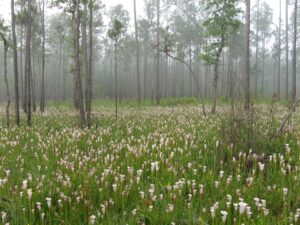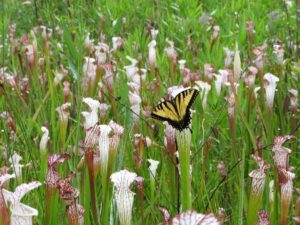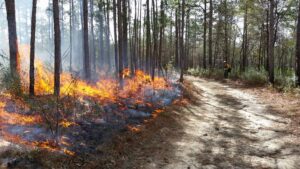I am a “destination” not a “journey” person. I’m usually moving pretty fast, bouncing from one task to another, from one place to the next. When traveling around for article interviews and research (or even for fun), trying to beat the arrival time Google Maps gives me when I type in where I’m heading is my favorite game. I want to get there and get started and then get on to what’s next.
This mindset makes me efficient, but I know I often buzz right past things, missing moments and opportunities that a slower pace would reveal. In recent years, I’ve made an intentional effort to stop and smell the roses, so when I read a faded sign at Splinter Hill Bog Preserve in South Alabama that directed, “Stand still—and look until you really see,” I felt it had been put there just for me.

(The Nature Conservancy in Alabama/Facebook)
But while a bounty of blooms surrounded me, I quickly learned I did not want to stick my nose in these flowers. At the headwaters of the Perdido River in Baldwin County, the bog site holds 12 species of carnivorous flora that lure, catch, and eat insects (and sometimes small lizards and frogs), including one of the world’s largest populations of white-topped pitcher plants, plus sundews and butterworts, as well as other rare plants in its multiple, intertwining habitats: sandy longleaf pine forests, seepage bogs, and coastal blackwater stream swamps. Numbers of all four pitcher plant species in the bog are dwindling globally, and several declining animal species make their home here too: the gopher tortoise and Bachman’s sparrow.
Currently, two tracts of bog totaling more than 3,000 acres are being protected, one parcel by The Nature Conservancy, and adjacent acreage, by the state’s Forever Wild Land Trust. And this gem hides in plain sight, right off I-65, just one more entry on a long list of spots all over Alabama that I, and many others, overlook. Despite making hundreds of trips down the stretch of interstate it’s near, I was unaware the Splinter Hill Bog Preserve existed until a few months ago.
Following interviews with Chris Oberholster, director of external affairs for The Nature Conservancy in Alabama, for another assignment, he invited me to visit the bog. I hesitated. I wanted to move on. But it wasn’t even out of my way, just an easy turn off the same highway that took me back to I-65, so I accepted.

(The Nature Conservancy in Alabama/Facebook)
The decision rewarded me with a landscape unlike any other. Amid an ocean of knee-high grasses baking in early summer sun, stood hundreds of white-topped pitcher plants, their milky funnel-like petals with burgundy striations popping against all the green. A closer look showed delicate fuchsia orchids swaying in the breeze and the spiky, sticky leaves of glistening pink sundews—also bug killers—carpeting the ground. Stands of tall and straight longleaf pines edge its wide-open fields.
On our walk among the wildflowers, Oberholster explains the importance of the Splinter Hill Bog Preserve. “This site is one of the last remaining pitcher plant or seepage bogs in the world,” he says. “And it’s interesting because even though this is a high-rain area, the soil here is nutrient-poor. So, the plants, like the pitchers, that eat insects, that’s how they’ve adapted to the soil.” The insects provide the nitrogen needed to sustain them. Similar adaptations allow every plant and animal living in the bog to thrive in the distinct habitat.
Preserving this unique ecosystem and all the life it supports motivated TNC and Forever Wild to purchase and protect the bog but, as Oberholster explains, simply ensuring it doesn’t disappear isn’t the sole driver for TNC’s involvement here. A key element of the bog is fire. “Lots of sunlight is vital for this habitat, so there are either no trees or where there are trees, like the pines here, they are widely spaced enough to let full light down to ground level,” he says. “But fire is crucial too.”

(The Nature Conservancy in Alabama/Facebook)
Regular fires don’t destroy pitcher plant bogs, they refresh them. “Fire here is a force of life,” Oberholster says, “a must for these places.” Wildfires are a rarity in modern Alabama, and that’s one reason pitcher plant bogs are so rare today. “When there is a wildfire, we put it out quickly, which is understandable, since they can threaten property,” Oberholster says. And many landowners and public land managers don’t understand the value of prescribed fires. So, TNC is using Splinter Hill to teach them. “We protect this site because it is special and amazing, but we also use it as a demo site to train others on how to properly use fire to maintain these kinds of lands and keep them healthy,” he says.
Thanks to these efforts, now anybody can exit off the interstate, pull into the gravel parking lot, and take a walk back in time. And the stop is more than worth your precious time. Stroll more than four miles of trails and look for the elusive pot-of-gold lilies. Peek into a pitcher plant’s namesake vessel to see if it’s captured a snack. Listen for the blue grosbeak’s high-pitched peeps and warbles.
Oberholster has a few personal favorites. “The threadleaf sundew, with its long, ribbon-like leaves sticking up, can be hard to spot, but if you catch them backlit by the sun, you can see all their little sticky dew drops, the death trap for bugs, sparkling. It’s beautiful.”




